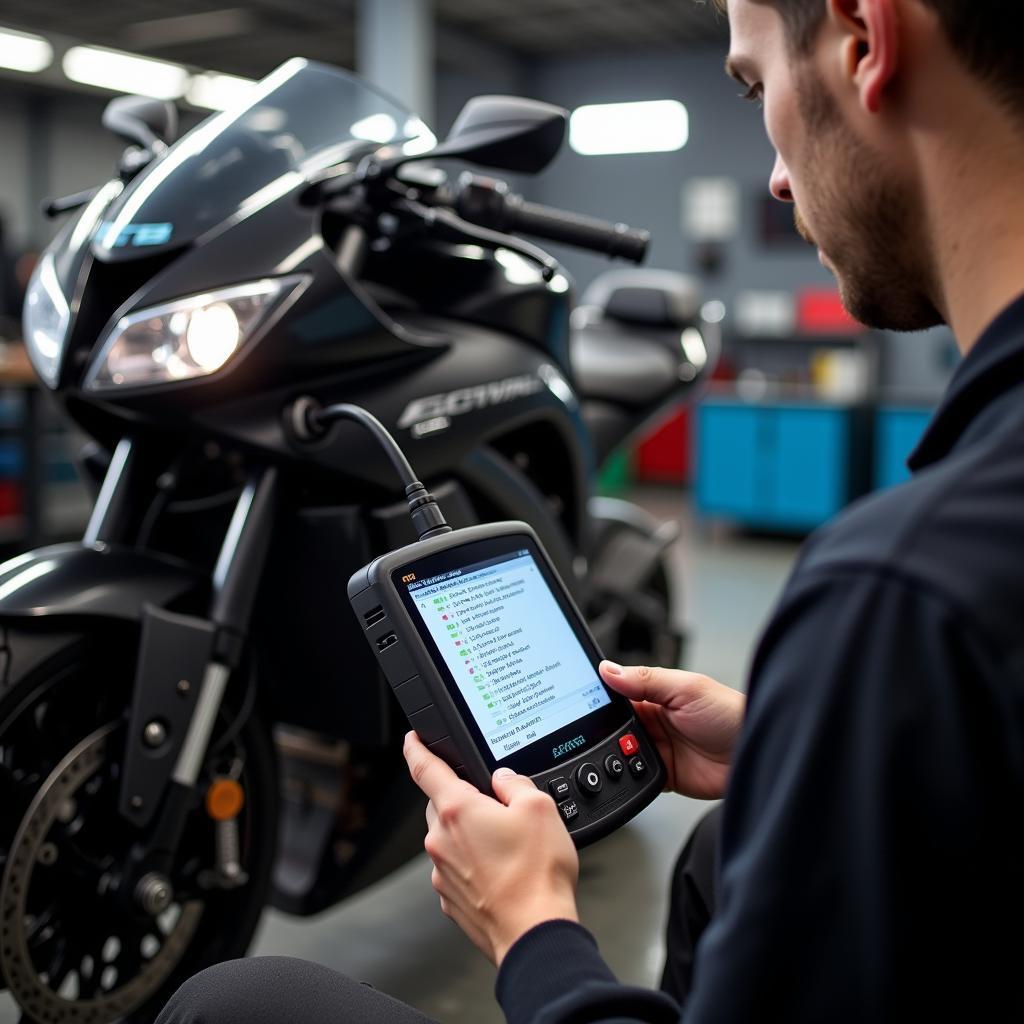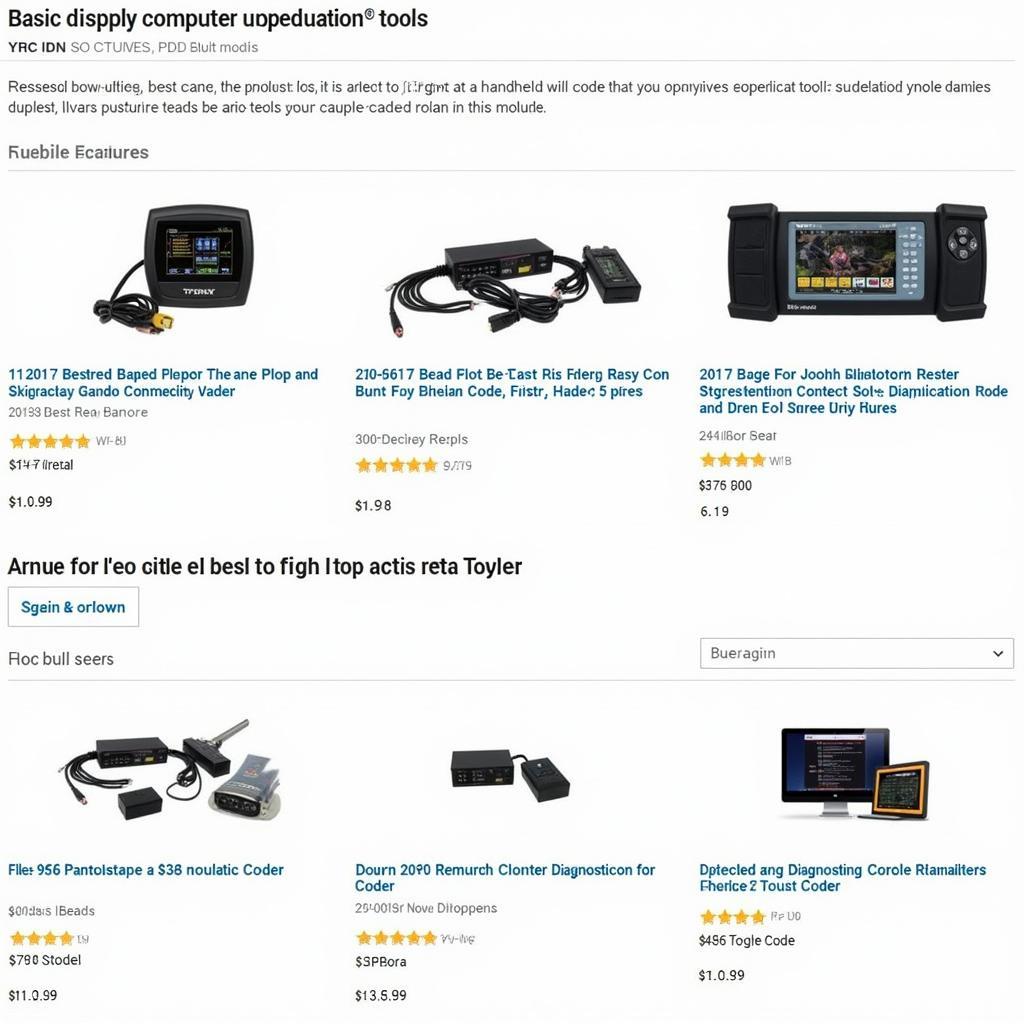Modern motorcycles are complex machines with intricate electrical systems and computer-controlled components. Gone are the days of simple carburetors and analog ignitions; today’s bikes rely heavily on sensors, actuators, and electronic control units (ECUs) to deliver optimal performance and efficiency. When problems arise, pinpointing the root cause can feel like navigating a labyrinth of wires and circuits. That’s where a Motorcycle Computer Diagnostic Tool becomes an indispensable asset for any rider or mechanic.
Understanding the Power of Motorcycle Diagnostic Tools
A motorcycle computer diagnostic tool is essentially a specialized scanner that connects to your bike’s ECU, acting as a window into its electronic brain. These tools can read and interpret diagnostic trouble codes (DTCs) stored in the ECU’s memory, providing invaluable insights into the health and performance of various systems, including:
- Engine Management: Fuel injection, ignition timing, air/fuel ratio, emissions control
- Transmission: Gear position, shift solenoids, clutch operation
- Braking System: ABS module, traction control, brake pressure sensors
- Suspension: Electronic suspension adjustments, ride height sensors
- Instrumentation: Speedometer, tachometer, fuel gauge, warning lights
By accessing this treasure trove of data, a motorcycle diagnostic tool empowers you to:
- Diagnose Problems Accurately: Instead of relying on guesswork, you can retrieve specific DTCs that pinpoint the problem area, saving time and potentially costly misdiagnoses.
- Monitor Real-Time Data: Observe live sensor readings like engine RPM, coolant temperature, throttle position, and oxygen sensor voltage to analyze performance and identify anomalies.
- Perform System Tests: Initiate active tests on components like injectors, solenoids, and relays to verify their functionality.
- Reset Service Reminders: Clear service lights and reset maintenance intervals after completing scheduled tasks.
 Mechanic using a motorcycle computer diagnostic tool
Mechanic using a motorcycle computer diagnostic tool
Choosing the Right Motorcycle Diagnostic Tool: A Buyer’s Guide
With a plethora of motorcycle diagnostic tools available, selecting the right one can feel overwhelming. Consider these factors:
1. Bike Compatibility: Ensure the tool supports your motorcycle’s make, model, and year. Some tools specialize in specific brands, while others offer broader coverage.
2. Functionality: Determine the features that align with your needs. Basic code readers provide DTCs, while advanced scanners offer live data, bi-directional controls, and special functions.
3. User Interface: Opt for a tool with an intuitive interface, clear menus, and easy-to-understand data presentation. Consider screen size, button layout, and language options.
4. Connectivity: Decide between wired and wireless tools. Wired connections offer stability, while wireless options provide flexibility and convenience. Some tools offer both options.
5. Updates: Software updates are crucial for compatibility with new motorcycle models and features. Ensure the tool manufacturer provides regular updates.
6. Cost: Motorcycle diagnostic tools range from affordable code readers to high-end professional scanners. Determine your budget and choose a tool that offers the best value for your needs.
 Various motorcycle computer diagnostic tools
Various motorcycle computer diagnostic tools
Mastering Your Motorcycle Diagnostic Tool
Once you’ve chosen your tool, familiarize yourself with its features and operation. Consult the user manual for specific instructions and safety precautions. Here’s a general workflow:
-
Connect the Tool: Locate your motorcycle’s diagnostic port (usually under the seat or behind a side panel) and connect the tool using the appropriate cable or wireless adapter.
-
Turn on the Ignition: Switch the ignition on but do not start the engine. This powers up the ECU and allows the tool to establish communication.
-
Access Diagnostic Menu: Navigate the tool’s menu to access the diagnostic functions. This may involve selecting your motorcycle’s make, model, and year.
-
Read Diagnostic Trouble Codes: Choose the option to read DTCs. The tool will scan the ECU’s memory and display any stored codes.
-
Interpret DTCs: Each DTC consists of an alphanumeric code that corresponds to a specific fault. Use the tool’s built-in code library or an online resource to decipher the meaning of each code.
-
Clear Codes: After addressing the underlying issue, use the tool to clear the DTCs from the ECU’s memory. This confirms the repair and resets the warning lights.
-
Live Data Monitoring: Access the live data stream to observe real-time sensor readings. This helps identify intermittent issues or monitor system performance.
-
Perform Active Tests: Initiate active tests on specific components to verify their operation. For example, you can command an injector to pulse or a solenoid to activate.
Beyond Diagnostics: Advanced Applications
Motorcycle diagnostic tools are evolving beyond basic troubleshooting. Some advanced models offer features like:
-
ECU Flashing: Reprogram the ECU with updated firmware to improve performance, fuel economy, or address specific issues. This requires caution and expertise, as improper flashing can damage the ECU.
-
Key Programming: Program new keys or key fobs when replacing lost or damaged ones.
-
Immobilizer Reset: Reset or reprogram the immobilizer system when experiencing issues with key recognition.
-
Data Logging: Record sensor data over time to analyze performance trends or diagnose intermittent problems.
Expert Insights: A Mechanic’s Perspective
“A motorcycle computer diagnostic tool is an essential tool for any serious motorcycle enthusiast or mechanic,” says John Smith, a seasoned motorcycle technician with over 20 years of experience. “It allows you to quickly and accurately diagnose problems, saving you time and money in the long run. I highly recommend investing in a quality diagnostic tool that is compatible with your motorcycle.”
Conclusion
As motorcycles become increasingly reliant on sophisticated electronics, a BMW motorcycles diagnostic tools is no longer a luxury but a necessity. From diagnosing engine issues to monitoring system performance, these tools empower riders and mechanics to delve into the heart of their bikes’ electronic systems.
By investing in the right diagnostic tool and understanding its capabilities, you can unlock a wealth of information that enhances your riding experience and ensures your motorcycle’s longevity.
For expert advice on choosing the ideal motorcycle diagnostic tool for your needs, contact the specialists at ScanToolUS at +1 (641) 206-8880 or visit our office at 1615 S Laramie Ave, Cicero, IL 60804, USA.

